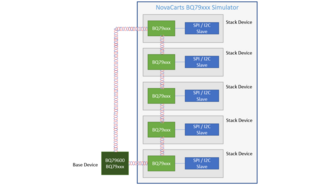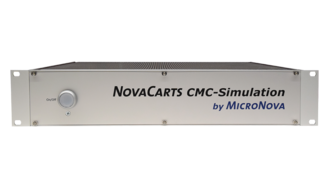New MicroNova Simulator works with industry-leading battery cell monitors and balancers from Texas Instruments to advance battery management system technology
MicroNova now offers CMC simulation for TI’s BQ79718-Q1 devices
MicroNova has enhanced its NovaCarts Cell Module Controller (CMC) simulator to support the latest high-accuracy battery cell monitors and balancers from Texas Instruments (TI), making it easier and faster to test battery management systems (BMS). The BQ79718-Q1 device serves as a monitoring, balancing and protection unit for battery modules in high-voltage BMS.
Simulating CMCs minimizes changeover times and downtimes on hardware-in-the-loop (HiL) simulators, resulting in cost savings. The NovaCarts CMC simulator features a daisy-chain communication interface to the bridge device on the master board of the BMS or the master control unit (MCU), ensuring precise timing as well as high-performance simulation. The CMC simulator is able to simulate up to 35 CMC chips at any one time, and engineers involved in the development and testing of BMS systems can also combine several CMC simulators to simulate batteries with a very large number of cells.
“The BQ79718-Q1 battery cell monitor and balancer from TI allows automakers to maximize the true range of their EV with high-precision battery cell voltage measurements down to 1 mV. Together with the NovaCarts CMC simulator, it can be a highly effective and efficient way for engineers to prototype a BMS and get to market faster,” said Sam Wong, vice president and general manager for Battery Management Solutions at TI.
Reducing Complexity and Costs
As a component of the BMS of a high-voltage storage systems for both electric vehicles and stationary energy storage systems, CMCs allow the batteries to operate safely and deliver high performance. To achieve this, they continuously monitor the voltage and temperature of the individual cells. The NovaCarts CMC simulator provides a cost-effective and safe solution for performing tests on BMS and simplifying and accelerating their development. The fact that CMC simulation on the HiL simulator can easily be combined with actual cell module controllers also reduces the cost of the HiL system. The solution therefore constitutes an ideal extension to BMS HiLs.
“Setting up a HiL with real CMCs is complex because it requires simulating the actual cell voltages of the battery and as well as the temperature sensors. High overall voltages are generated in the HiL when emulating high-voltage batteries, increasing complexity in terms of reliability and hence the costs involved. The simulation of the cell module controller chips acts as a countermeasure to this,” explains Detlef Naundorf, Product Manager at MicroNova. “At the same time, the NovaCarts CMC simulator can be used as a standalone solution for software development and testing. It’s also easier to recreate and test fault situations than with a real-life setup.”
To date, the NovaCarts CMC simulator supported the BQ79616-Q1 and BQ79618-Q1 devices from TI. The integration of the BQ79718-Q1 expands MicroNova’s CMC simulator range to include this powerful chip.
Press Contact
For further information about the solutions from MicroNova, please contact our press team. If you would like to receive future press releases, please send us an e-mail with the topics you are particularly interested in to presse@micronova.de. We look forward to your message!
MicroNova AG
Press Contact
Unterfeldring 6
D-85256 Vierkirchen
Phone: +49 8139 9300-824
Fax: +49 8139 9300-80
E-Mail: presse@micronova.de
Image material
High-resolution images can be downloaded directly from the respective press releases. The photos and screenshots are free for editorial use only. Please cite the following copyright unless otherwise noted: MicroNova.
About MicroNova
MicroNova has been a software and systems vendor since 1987 and offers products, solutions and services in four business areas: testing of automotive electronics, technology consulting, management of mobile radio and communication networks as well as the distribution of IT, digitalization and project management solutions. 300 experts work with technological competence and passion at the headquarters in Vierkirchen near Munich and at seven other locations in Germany and the Czech Republic. Numerous customers such as Audi, BMW, Continental, Telefónica Germany, Vodafone Germany and Volkswagen rely on MicroNova's expertise.




